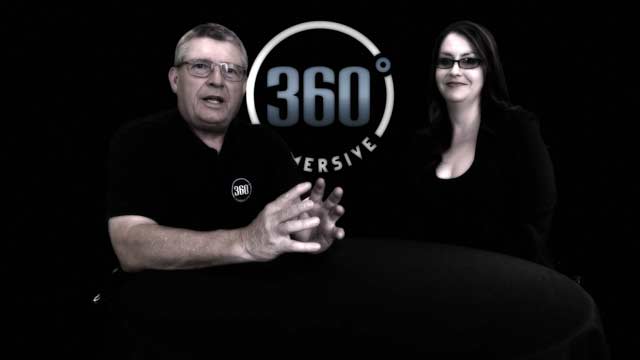David Cleverdon of 360 Immersive and Breean McKinney of Stevens-Henager College, Discuss the Use of Virtual Reality to Understand Social Issues
Cleverdon: Hi, this is David from 360 Immersive. You joined us on a previous episode, where we were discussing education, training, and virtual reality. Now, you’re from Stevens Henager.
McKinney: Stevens Henager College.
Cleverdon: Tell us a little bit about it and then we’ll jump into the topic for today.
McKinney: I am the business development rep for Stevens Henager College. I get to basically use my one skillset, which is talking to people for a living, which is amazing. That’s part of the reasons why I’m so excited about education and different tools we can use to follow our passion.
Cleverdon: Today, we’re going to discuss a couple of different topics, but it’s all about using virtual reality, or VR, to build something that most people don’t think about. They think of gaming, they think of entertainment, they think maybe VR music videos, but we can actually build empathy, and we can build understanding in a certain circumstance or a person’s life. To me, it’s almost magical. We actually have an Understanding Schizophrenia app. It’s a download on iOS and Android, and it allows somebody to experience what it’s actually like to suffer from that disorder. As somebody that has a social work background, and you’re in the education and training industry, you’ve got it all.
McKinney: Sometimes it comes in handy to have a social work background.
Cleverdon: Tell us what you think about VR as a technology and in context of building and understanding.
McKinney: In social work, there is a really big concept of The Other. The Other is anybody other than ourselves or the group that we associate with or feel like we have belonging with. There’s always a fear and a certain amount of insecurity based upon whoever we perceive to be The Other. In mental health in particular, if we consider ourselves to be sane, anybody who is suffering from any behavioral patterns or experiences that are different from our own, that’s The Other. Developing empathy is how we remove that Otherness type situation, whether that’d be social issues such as racism or misogyny, and especially for first responders and individuals that are dealing with people that aren’t acting quite right in those situations where they show up to a house, such as schizophrenia.
Cleverdon: When you’re actually out as a social worker, I mean, it’s a hugely challenging job. Number one, generally, you don’t go in armed–
Cleverdon: I’m being facetious there. You have to deal with people that perhaps are upset if you’re doing a home assessment, maybe potentially might be recommending that their trial is no longer safe there. In fact, we have an app, and we were just talking about it. You didn’t realize that we have an app that actually documents that whole process, where we do a roleplay where we actually take somebody in virtual reality in doing a home assessment. So, you’ll have to look at all the potential. Are there tobacco products? Is there alcohol? In some cases, we have weapons, we pharmaceuticals; we have medication that a child can get their hands on. Because VR allows you to be situational, where you can look all over and you can find those items, or you may realize you’re missing those items. That’s why it’s a great tool.
McKinney: What’s really awesome to me about that is that when you’re in that moment like you just said, they’re going into someone’s home, they’re aware that you’re not necessarily going to be on their side. Because you have to be so hypervigilant because you have to make sure they’re not in between you and the door, or there’s not five pit bulls that are going to come out of the back bedroom, or an angry boyfriend coming in from the side door, you’re not going to be able to use that processing part of your brain to be looking for those hazards and those dangers in making the assessment. But if you’re able to train with that type of an app beforehand, it becomes second nature for you to be making assessments of those items, as well as being able to stay present in the moment to protect yourself.
Cleverdon: And in the situation. You know, if you think about it, you take any athlete – a competitive athlete, they train, they practice, they build up the muscle memory, they do all the things that make them go out there and perform at the highest level.
McKinney: Without having to think about it, they just know how to do it.
Cleverdon: If you think about it, why don’t we take our first responders, the folks that are on the frontlines when it comes to social work and mental health and fire an EMS and give them that same luxury of training because, let’s face it, they do a lot of tabletop and live simulations. There’s no doubt about that in their existing training, but they can’t duplicate it easily, and it’s costly.
McKinney: It’s also safely. How many dangerous situations do you have to be in while you’re trying to learn this skill, while in sports, the risks or stakes are not as high? When you’re practicing day after day after day, it’s not a real game, so when the real game comes, you’re prepared. With social work, with first responders, you don’t get that luxury. You’re right there in the moment where it is volatile, it is high stakes, you are making decisions at the moment that can impact your life or somebody else’s life, and with VR, you are able to get that luxury.
Cleverdon: You bring up sports. We do know that in the NFL and on higher collision teams, they usually are. It is a new tool of choice. Virtual reality is where it’s at. In fact, if you’re recruiting and you’re coming in and looking at a team, one of the first questions that a lot of athletes are asking now is: What are we doing about virtual reality training because I hear so much about it in the news? It makes a difference, not only for the team’s performance, but for the individuals, and that’s what it’s all about, it’s getting that individual to their highest level of achievement.
McKinney: Yeah, being able to optimize what they’re capable of with reduced risk and reduced liability, absolutely.
Cleverdon: Coming back to that point of empathy, for instance, a law enforcement officer, he’s trained to react in a certain way if somebody’s aggressive. What we’d like to think about is that there’s maybe another option if they can understand that maybe their reality – and I love that word, reality – is different. They hear voices–
McKinney: Auditory.
Cleverdon: They see things. They see spiders and bugs and they see spectral images. To a normal person, hugely disconcerting.
McKinney: Yes, to see somebody responding to the internal stimuli, yeah, and it could come off, especially to our police officers or first responders who are trained, to, “This person is aggressive,” and they automatically go into certain training parameters. To be able to understand that this person is responding to internal stimuli, whether that’d be tactile, whether that’d be auditory, whether that’d be visual, and be able to have those tools to de-escalate that type of situation the same way that they’re trained to respond to other types of situations and scenarios.
Cleverdon: It’s a new tool. It’s a new learning experience. Virtual reality, when you understand, and you build empathy, I just love it.
McKinney: It literally gives us the opportunity to walk a mile in somebody else’s shoes.
Cleverdon: I love that saying.
McKinney: Its cliché, it is a ubiquitous kind of statement, but there really is no better way that we currently have where we’re really able to say, “Wow, I see what they see now,” or, “I’m experiencing what they’re experiencing.”
Cleverdon: Cliché or not, everybody understands that statement.
McKinney: Yeah, absolutely.
Cleverdon: It is a great statement. Thank you.
McKinney: Absolutely.
Cleverdon: And thank you. This is David from 360 Immersive.


